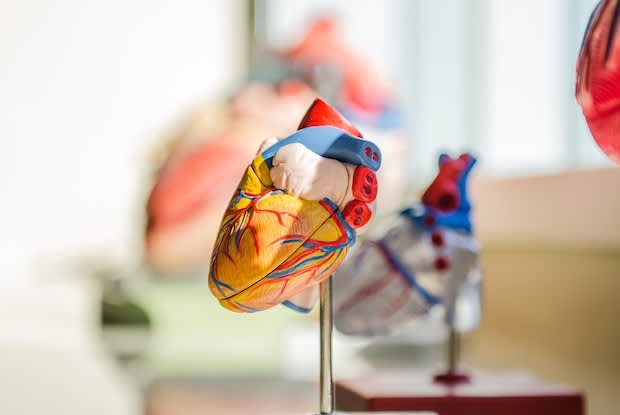Table of Contents
I. How Yoga can Protect the Heart
II. Risk Factors for Cardiovascular Disease
III. Evidence in Support of Yoga for Cardiovascular Health
a. Yoga and Metabolic Syndrome: A 1-year Intervention
b. Yoga and Modifying Risk Factors for Cardiovascular Disease
IV. Pranayama: Yoga-Based Breathing Techniques that Support Cardiovascular Health
b. Pranayama and the Vagus Nerve
V. Yoga: A Preventative Measure for Cardiovascular Disease
Yoga and Cardiovascular Disease
How Yoga can Protect the Heart
Cardiovascular disease (CVD) is the number one cause of death and disability worldwide. [1]
According to the World Health Organization, by 2030, it is expected that 23.6 million people will die from CVDs, mainly from heart disease and stroke. [2]
Yoga incorporates a mixture of low-impact movement through postures, breathing techniques, and meditation. Yoga may be an alternative treatment for cardiovascular disease due to its cost-effectiveness, accessibility, and efficacy.
Yoga can help to manage stress and improve well-being, which may decrease one’s risk of CVDs.
Risk Factors for Cardiovascular Disease

CVD is an umbrella term for a group of disorders of the heart and blood vessels. CVD disorders include hypertension (high blood pressure), coronary heart disease (heart attack), cerebrovascular disease (stroke), peripheral vascular disease, heart failure, rheumatic heart disease, congenital heart disease, and cardiomyopathies.
Coronary artery disease (CAD) is the most common form of heart disease. CAD occurs when one or a few of the coronary arteries narrows or becomes completely blocked. In CAD, blood vessels become damaged due to a lack of blood supply and oxygen. Vessels begin to narrow and may harden — this process is called atherosclerosis (hardening of the arteries) [3]
Non-communicable diseases, such as CAD, contribute to approximately 50 percent of global mortality. [1]
Get savings updates for Prescription Medications
It’s essential to understand the risk factors associated with CAD to mitigate risks. Some factors are within our control to change, while others are not.
Risk factors such as smoking, an unhealthy high-fat diet, too much alcohol, unhealthy weight, high blood pressure, high cholesterol, and a sedentary lifestyle all increase one’s risk of CAD. Psychological risk factors such as stress, depression, and hostility also contribute to one’s risk of CAD.
Risk factors for CAD you cannot change include age, sex, family history, heritage, and environment. Environmental factors, such as the lack of access to healthy food, safe drinking water, and health services, can influence heart health.
Evidence in Support of Yoga for Cardiovascular Health

Many of the risk factors for CAD are within our control to change. Feeling empowered to take control of your health is an amazing place to begin.
There is a surprising amount of scientific evidence that supports yoga for cardiovascular health promotion and CVD prevention.
Yoga and Metabolic Syndrome: A 1-Year Yoga Intervention
A study from April 2015 looks at the effects of a 1-year yoga intervention on cardiovascular risk factors older adults with Metabolic syndrome (MetS).
MetS is a grouping of cardiovascular risk factors associated with CVD and diabetes mellitus. Lifestyle changes applied to individuals with MetS can considerably decrease disease risk.
Cardiovascular risk factors, such as central obesity, hypertension, dyslipidemia, and hyperglycemia, were examined in study subjects. The results of the study conclude that yoga exercise improves cardiovascular risk factors. Measures for central obesity and blood pressure in older adults with MetS improved. Waist circumference improved, and there was a decrease in systolic blood pressure. [4]
The study concludes by saying that the findings support yoga in managing MetS. The role that yoga plays in health promotion is acknowledged. A reduction in MetS risk factors is a good sign. As MetS risks decrease, the risk of CVDs decreases as well.
Yoga and Modifying Risk Factors for Cardiovascular Disease
A study published in 2014 examines how yoga can influence CVD risk. The study examines how yoga affects risk factors for MetS and CVD, specifically. The review was a meta-analysis of 32 studies existing in the literature. Postural-based yoga interventions were the focus of this meta-analysis. Yoga intervention groups are compared to non-exercise control subjects.
The findings demonstrate promising evidence for yoga in improving cardio-metabolic health. Yoga is shown to decrease the risk of CVDs. The yoga intervention groups, compared to non-exercise control groups, showed improvements for systolic blood pressure, low-density and high-density lipoprotein cholesterol, total cholesterol, triglycerides, body weight, and heart rate. [5]
Pranayama: Yoga-Based Breathing Techniques that Support Cardiovascular Health

What is Pranayama?
Pranayama is the yogic term for breath regulation or control. Many different forms of pranayama use varying techniques and exercises for breath control. Pranayama — the fourth limb in the eightfold path of yoga — controls the energy pathways in the body and can create a quieting of the mind. These breathing techniques may also help to strengthen respiratory organs.
Not only does Pranayama help to strengthen respiratory organs through controlled breathing, but it also plays a role in mindfulness and relaxation. Yoga relaxation techniques (such as pranayama) promote the activation of our parasympathetic nervous system (PNS). The PNS creates a calming rest-and-digest state for the body. Yoga and mental health do go hand in hand, after all.
A breathing technique called Nadi Shodhana (alternate nostril breathing) can help to achieve a calm state. This pranayama technique can also lower the heart rate and reducing stress. Try this video explanation by Yoga with Adriene below and see how you feel after a few deep breaths.
Pranayama and the Vagus Nerve
During the slow pranayama technique of alternate nostril breath, respirations are deeper. There is an increased duration of expiration (exhale). Long pranayama breathing resets the autonomic nervous system. Deep breathing shifts our body into a parasympathetic response. Shorter inhales, accompanied by longer exhales, strengthens vagal nerve traffic. Heart rate is reduced, and heart rate variability increases. [6]
The vagus nerve is the longest cranial nerve in the body and runs from the brain stem into part of the colon. The vagus nerve has both sensory and motor functions. Vagus nerve sensory functions include somatic (sensations felt on the skin or in muscles) and visceral components (sensations felt in organs). Vagus nerve motor functions include stimulating muscles in the throat (gag reflex) and muscles in the heart — the vagus nerve can help lower resting heart rate. [7]
The vagus nerve is also known as the emotional regulation pathway in the body. Vagal circuitry is closely linked with systems in the body that regulate cortisol (the body’s stress hormone). Stress is a risk factor for CVD. Thus, when vagal nerve circuitry is strengthened through pranayama, this may act as a form of stress relief (potentially decreasing cortisol). [8]
The finding that specific pranayama techniques can strengthen vagal nerve traffic is important. Improvements in vagal tone are essential for stable cardiovascular health. [9]
Pranayama is very effective in reducing heart rate and cardiovascular risks because of its ability to regulate heart rate, heart rate variability, and autonomic nervous system activity. Pranayama and its ability to strengthen vagal nerve traffic may play a role in stress reduction as well. [6]
Yoga: A Preventative Measure for Cardiovascular Disease

The combination of yoga postures, breathing techniques, and meditation provides many benefits to the mind and body. Each of these elements of yoga positively affects cardiovascular health and helps to mitigate risks.
The movements associated with yoga postures have been shown to promote a healthy weight. Breathing techniques, such as alternate nostril pranayama, can help strengthen the vagal nerve pathway and lower blood pressure. The calming state you feel during meditation helps to quiet the nervous system and ease stress. [10]
Yoga offers less strenuous and lower impact movements compared to many other forms of exercise. Yoga postures can be modified to suit the individual, making it a more accessible form of movement for people that are hesitant to exercise or for those that are going through cardiac rehabilitation. Some nurse practitioners are even offering yoga into cardiovascular rehabilitation programs and classes.
Because of yoga’s all-encompassing approach to wellness, including aspects of movement, breath regulation, and meditation, it should be taken seriously as a means of promoting cardiovascular health and minimizing the risk of CVDs.
The content in this article is intended for informational purposes only. This website does not provide medical advice. In all circumstances, you should always seek the advice of your physician and/or other qualified health professionals(s) for drug, medical condition, or treatment advice. The content provided on this website is not a substitute for professional medical advice, diagnosis or treatment.
